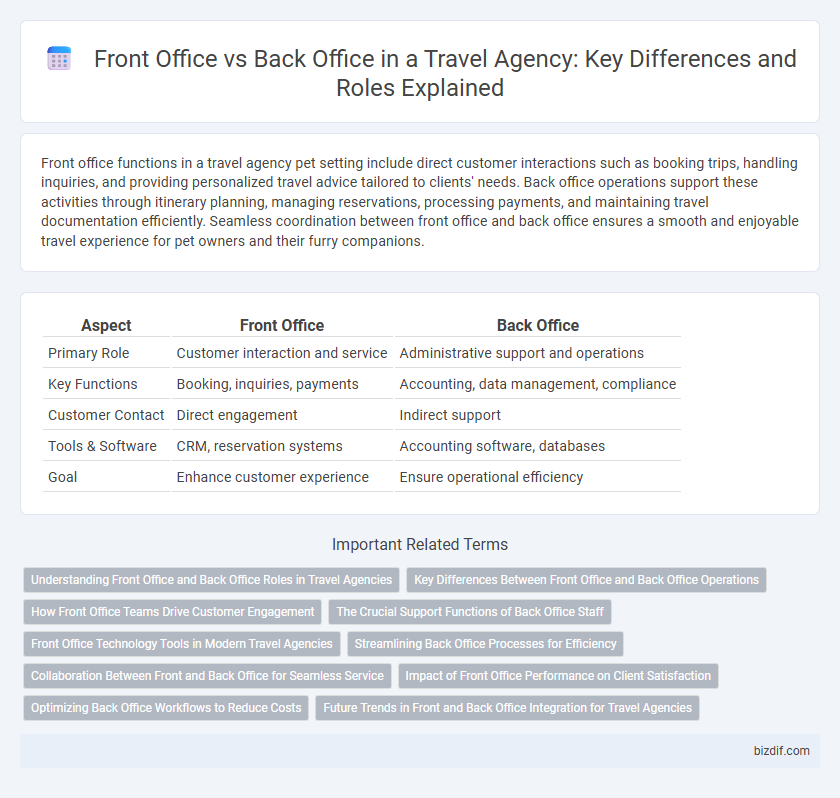Front office functions in a travel agency pet setting include direct customer interactions such as booking trips, handling inquiries, and providing personalized travel advice tailored to clients' needs. Back office operations support these activities through itinerary planning, managing reservations, processing payments, and maintaining travel documentation efficiently. Seamless coordination between front office and back office ensures a smooth and enjoyable travel experience for pet owners and their furry companions.
Table of Comparison
| Aspect | Front Office | Back Office |
|---|---|---|
| Primary Role | Customer interaction and service | Administrative support and operations |
| Key Functions | Booking, inquiries, payments | Accounting, data management, compliance |
| Customer Contact | Direct engagement | Indirect support |
| Tools & Software | CRM, reservation systems | Accounting software, databases |
| Goal | Enhance customer experience | Ensure operational efficiency |
Understanding Front Office and Back Office Roles in Travel Agencies
Front office roles in travel agencies involve direct customer interaction, including booking flights, managing reservations, and providing personalized travel advice, ensuring a seamless client experience. Back office functions focus on administrative support, such as data management, accounting, and supplier coordination, which are essential for operational efficiency. Understanding the distinct yet complementary roles of front office and back office teams enhances overall service delivery and business performance in travel agencies.
Key Differences Between Front Office and Back Office Operations
Front office operations in a travel agency involve direct customer interactions such as booking flights, handling inquiries, and providing personalized travel assistance, enhancing customer experience and satisfaction. Back office operations focus on administrative tasks like ticket processing, itinerary management, financial accounting, and supplier coordination, ensuring efficient support and operational flow. The key difference lies in front office dealing with client-facing services while back office manages internal processes critical for smooth travel service delivery.
How Front Office Teams Drive Customer Engagement
Front office teams in travel agencies play a crucial role in driving customer engagement through direct interaction with clients, offering personalized travel consultations and real-time support. Their responsiveness to inquiries and ability to tailor travel packages enhance customer satisfaction and loyalty, directly impacting booking rates and repeat business. Efficient front office operations also facilitate seamless communication between customers and back office departments, ensuring smooth travel planning and execution.
The Crucial Support Functions of Back Office Staff
Back office staff in travel agencies play a crucial role by managing essential support functions such as booking confirmations, payment processing, and itinerary updates, ensuring smooth operations behind the scenes. Their expertise in data management, supplier coordination, and customer record maintenance directly impacts client satisfaction and operational efficiency. Investing in skilled back office personnel enhances the overall travel experience by reducing errors and allowing front office agents to focus on personalized customer service.
Front Office Technology Tools in Modern Travel Agencies
Front office technology tools in modern travel agencies include advanced booking engines, customer relationship management (CRM) systems, and interactive chatbots that enhance client engagement and streamline reservations. These tools enable real-time access to flight schedules, hotel availability, and pricing data, improving service accuracy and customer satisfaction. Integration with mobile apps and online payment gateways further supports seamless, efficient front office operations.
Streamlining Back Office Processes for Efficiency
Streamlining back office processes in a travel agency enhances operational efficiency by automating booking confirmations, payment processing, and customer data management. Integrating cloud-based systems reduces manual errors and accelerates transaction times, allowing front office staff to focus on customer engagement and personalized service. Efficient back office workflows improve overall productivity, enabling faster response to client inquiries and seamless coordination across departments.
Collaboration Between Front and Back Office for Seamless Service
Front office staff in a travel agency directly interact with customers, managing bookings, inquiries, and personalized services, while the back office handles administrative tasks such as ticketing, accounting, and itinerary preparation. Efficient collaboration between front and back office ensures real-time information sharing, minimizes errors, and enhances customer satisfaction through seamless service delivery. Integrated communication platforms and shared databases empower teams to coordinate effectively, driving operational efficiency and improving travel experience.
Impact of Front Office Performance on Client Satisfaction
Front office performance directly influences client satisfaction by ensuring efficient booking processes, personalized service, and prompt resolution of inquiries. Effective communication and proactive problem-solving at the front desk enhance traveler confidence and loyalty, leading to positive reviews and repeat business. High front office responsiveness reduces client wait times and increases overall travel experience quality, which is critical for maintaining competitive advantage in the travel agency industry.
Optimizing Back Office Workflows to Reduce Costs
Optimizing back office workflows in a travel agency involves streamlining reservation processing, automating invoicing, and improving data management to reduce operational costs. Implementing integrated software solutions enhances communication between departments, minimizes manual errors, and accelerates service delivery. Efficient back office operations directly contribute to lower overhead expenses and increased profitability without compromising customer experience.
Future Trends in Front and Back Office Integration for Travel Agencies
Travel agencies are increasingly adopting AI-driven tools and cloud-based platforms to seamlessly integrate front office customer interactions with back office operations, enhancing real-time data sharing and personalized service delivery. Advanced analytics and automation streamline booking processes, inventory management, and customer relationship management, driving operational efficiency. This integration supports adaptive customer experiences and predictive business strategies, positioning agencies competitively in a rapidly evolving travel industry.
Front office vs Back office Infographic

 bizdif.com
bizdif.com